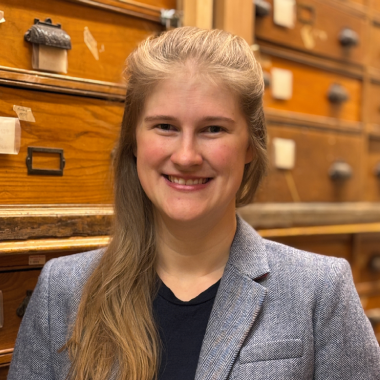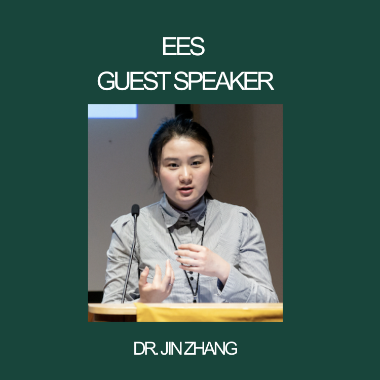Five EES Undergraduate Students Awarded the Warren and Anneliese Wood Research Award for Fall 2024
Each semester, our undergraduate students have the opportunity to apply for research funding with the Warren and Anneliese Wood Research Award! This award is made possible through the generosity of Dr. and Mrs. Wood to support undergraduate student-led research projects conducted under the mentorship of faculty in the Department. Dr. Wood is a graduate of Michigan State University, receiving B.S., M.S., and Ph.D. degrees from the then Department of Geology.
The purpose of this award is for undergraduates to request funding for non-salary research expenses including research equipment, sample analyses and supplies. Preference is given to applicants who have not previously received an award. Funding decisions are merit based are reviewed by the Undergraduate Affairs Committee with final approval from the Department Chair.
This semester, five undergraduate students are receiving this award!
Libby Ashby
Project title: Probing the Magmatic Source of Turkana’s Pliocene Shields Using Isotopic Techniques
Research mentor or advisor: Dr. Tyrone O. Rooney
Summary: Currently, there is very little existing isotopic data on the Turkana Pliocene shield volcanoes. Because of this, isotopic analysis of Turkana’s Pliocene shield formations will allow for a more complete interpretation of the magma sources that produced these rocks. This project will further our knowledge of heterogenous mantle sources during the evolution of the East African rift.
Jack Garrison
Project title: Leveraging stream flow to reveal complex flowpaths of groundwater to streams in Southwestern Michigan
Research mentor or advisor: Dr. Jay Zarnetske
Summary: The project I propose will use streamflow data to paint a clearer picture of the Augusta Creek watershed in southwest Michigan and its hydrologic properties, specifically water sources. In the Augusta Creek watershed, preliminary data suggests more groundwater flows into the stream in the lower region of the watershed. However, it is unclear where the groundwater originates due to hydrogeologic heterogeneity in the region. This project looks to determine and understand additive groundwater flows into the watershed, the importance this has for the scientific and hydrologic communities to understand the groundwater "plumbing," and develop and analyze discharge data more in depth of low relief landscapes with subsurface hydrologic complexity like in lower Michigan forests.
Low-relief landscape watersheds, like Augusta Creek in Michigan, are widespread across the Midwest, however these catchments and their hydrogeologic properties are understudied. With more data, modelling and analysis, the intrinsic hydrologic properties of watersheds similar in landscape to Lower Michigan can be better understood. This can help scientists better manage water systems and the flow of water in and around low-relief watersheds around the world. This data could be used to help scientists create models to track pollutants and water quality in similar hydrological conditions. The importance of the study of groundwater-surface interactions is that this data can be used to provide a framework for dealing with modern water resource issues like abundance, water quality and pollutant transport issues. This data can also be used to quantitatively evaluate ecosystem issues related to water ecology in riparian zones, provide insight to flooding and general water influx to regions prone to groundwater influence and many other topics involved with the hydrological research field.
Alexandra Huk
Project title: The Predicted Geochemistry of Ocean Worlds and its Impact on Subsurface Life.
Research mentor or advisor: Ella Cardoza (Graduate Student Mentor) and Dr. Matthew Schrenk (Principal
Investigator)
Summary: Understanding the potential geochemistry of subsurface oceans on the Icy Moons of our outer solar system (e.g., Europa, Titan, and Enceladus), including how they are modeled and analyzed is important to understanding their potential to host extraterrestrial life, and what signals we might look for.
This is fundamental to the field of astrobiology, since learning how microbes adapt to specific ocean chemistries and conditions can allow us to better study similar systems in analog environments and other moons and planets. This project is in support of graduate student Ella Cardoza’s Master’s thesis project on high pressure microbiology, in which I have been assisting her this fall. The significance of my own research specifically is working to adapt standard media based upon Earth’s ocean to be more like ocean world chemistry and to study the impact of growing microbes in these altered chemistries. For example, considering media with hire brine concentrations, elevated pH, or high ammonium concentrations. The application of both geochemistry and astrobiology is complementary to this project. To further expand this research, travel to NASA JPL to collaborate with Dr. Osama Alian, a graduate of the SchrenkLab and currently a post-doc in Dr. Laurie Barge’s origins and habitability lab would allow me to cultivate professional connections to my research and to widen my knowledge on this topic. I would also meet with Dr. Steve Vance, who is a participant in NASA’s ongoing Europa Clipper missions and an expert in understanding Ocean World geochemistry and the parameters going into modeling it.
Korbin Thompson
Project title: Understanding Links between Microbiology and Mineralogy within Hot Springs and Associated Volcanic Hazards
Research mentor or advisor: Ella Cardoza (Graduate Student Mentor) and Dr. Matthew Schrenk (Principal Investigator)
Summary: Microbes play a significant role in the Earth’s biogeochemical cycles, but in terms of volcanic ecosystems, the impact of microbial activities on biogeochemistry is limited, especially in Alaska. Alaska has a dynamic system of arc volcanoes across the state and understanding how microbes are impacted by volcano geochemistry and mineralogy could allow researchers to gain insight on microbial ecology of active volcanic systems. Additionally, understanding this connection can give geoscientists further insight as to predicting volcanic hazards. One system that is a location of interest is the Aleutian Island chain in southern Alaska, which is home to many volcanoes that are active today, many of which produce frequent earthquakes. Since the lab I am apart of, the Schrenk geomicrobiology lab, previously collected Alaska volcano samples in the Aleutian islands, I will use the funding to conduct mineralogical and DNA-based analyses of the samples, as well as travel to Alaska Volcano Observatory (AVO) in Fairbanks, AK to expand my research and knowledge on this field. This trip will be feasible with the help of Dr. Taryn Lopez, a Schrenk lab collaborator who works at the AVO in collaboration with the University of Fairbanks to monitor Aleutian eruptions and volcanic activity. Dr. Lopez is an expert in satellite-based remote sensing of volcanic hazards, which ties into my overall career interests in natural hazards. Learning from Dr. Lopez will add insight to this project, connecting my research and academics to professional development and potential future careers at USGS, AVO, and elsewhere.
Chase Zobl
Project title: Identifying the Mantle Source of the Pliocene Longipi Shield Volcano
Research mentor or advisor: Dr. Tyrone Rooney
Summary: The Pliocene shield volcanoes of the Turkana Depression are not fully understood, especially in terms of their mantle source. There is existing major and trace element data for many of these shield volcanoes, but there is a lack of key radiogenic isotope tracers required to characterize their mantle source. This work aims to resolve this data gap for the Longipi Shield volcano. A reliable understanding of this area's magmatic source will help us better understand magmatic sources during Pliocene volcanism in Turkana.
To donate to this wonderful opportunity, please navigate to https://givingto.msu.edu/gift/index.cfm?desi_code=A50713&desig_descrip=Wood%20Research%20Endowment


